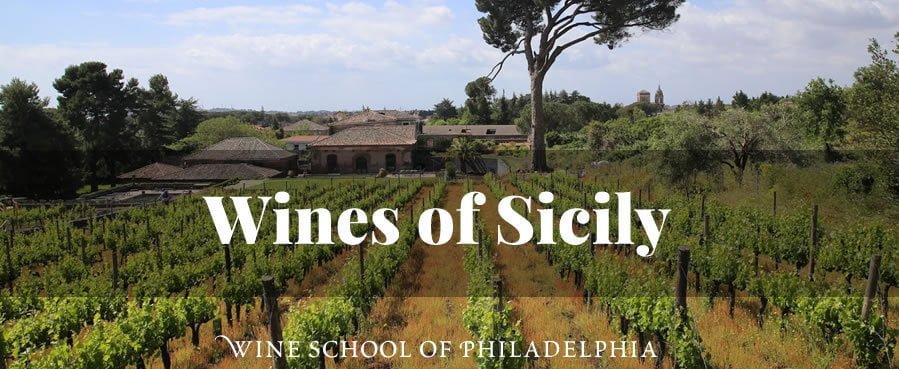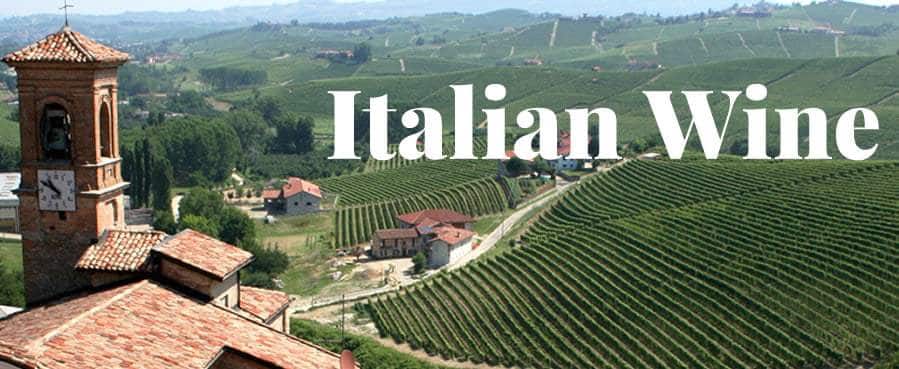Italy has a rich, deep history with wine – dating back thousands of years. Being the biggest producers of wine in the world, Italian wines are kept at a consistently immaculate standard. It is one of the many reasons that wine from the Italian regions is so widely respected.
Page Contents
- Available Classes
- Wine Regions of Italy
- Italian Grapes
Italian Wine Classes
A selection of the top wine classes being offered in Italian wine.
Italian Wine Regions
Tuscany
Not only is it Italy’s most mesmerizing region, but it is also the oldest wine-growing region. One of the region’s most significant wine-related stories is about their “Super-Tuscan.” In Tuscany, grape varietals that are not native-Italian are blended and called a “Super-Tuscan.” The major varietals used for this blend are Merlot, Syrah and Cabernet Sauvignon. Along with the Super Tuscan grapes, Tuscany also grows indigenous cultivars like Canaiolo, Colorino, and Trebbiano.
Sicily
Although greatly appreciated today, Sicilian wine was not always beloved by sommeliers. Because of the rich soil, high altitudes, and dry winds, the island’s vineyards can produce massive tonnage of grapes per acres. For decades, winemakers opted for quantity over quality, and the wines produced were of mediocre quality wines and left Sicily with a poorer reputation for this region deserved. With the help of winemaking legends like Giusto Occhipinti , Sicily managed to turn their reputation around. Today, they produce beautiful and magical wines from Frappato, Mascalese, and Nero d’Avola. They also are making white wines from Moscato Bianco and Grillo. There are also significant plantings of classic French varietals, including excellent Cabernet Sauvignon and Chardonnay.
Trentino-Alto Adige
In the Italian Northeast, you will find utter beauty in this unheard-of wine region. Because of the bordering countries, you can expect to find Italian, German and Ladin being spoken and also printed on the wine labels. The main varietals grown here are Pinot Grigio, Gewurztraminer, Chardonnay, Schiava, Lagrein, and Pinot Blanc. Although it rarely rains, this regions cool climate and rich soils creates almost perfect conditions for vines to flourish. Wine styles include zippy and mineral-driven white wines, which is one of the most common choices for the modern American wine drinker. There is also a growing movement toward natural wines, with some winemakers eschewing modernism for ancient techniques. One of the greatest examples of that trend are the amphora-aged orange wines that are all the rage with Master Sommeliers.
Abruzzo
Abruzzo has one of Italy’s most contested identities. Right along the coastline, this region is extremely mountainous and lush – with most of it being nature reserves and forests. Although the region wasn’t acknowledged at all as a respectable region, it has produced fine wine at a small scale for decades. Of particular note is the classic Italian rosé, Cerasuolo d’Abruzzo Now, the grapes grown here are consumed across Europe. In fact, wine experts claim that Abruzzo is the birthplace of many grape varieties now flourishing in Northern Italy and France.
Umbria
Although this region produces a fraction of the wine of competing regions, Umbria wines have become highly respected and noticed, especially the Sagrantino from Montefalco. Land-locked and situated east of Tuscany, the wines produced here tend to be fuller-bodied and age extremely well. Some of this area’s other signature grapes include Sangiovese, Grechetto, Merlot, and Trebbiano.
Sardinia
Sardinia might seem like a spitting image of Sicily – considering it’s an Italian island of a similar size – but this island has quite the unique portfolio. For one, it’s the only region in Italy that produces –and consumes– more beer than wine. Despite that, this region has some exquisite and unique varieties including Torbato, Nasco, Monica, Semidano and Vermentino. The terroir here is just as vast and has, in turn, aided the development of quality grapes that are slowly being recognized internationally.
Puglia
Located at the southern heel of Italy, this wine region has a geographical variety like no other. In the south, vines are grown on sandy but nutrient-rich flat vineyards. In the north, vineyards are found in hillier terroirs. These differences in soil create a massive difference in the wine produced here too. The varieties in the south are Primitivo and Negroamaro. In the north are the more classical central Italian grapes of Sangiovese and Montepulciano.
Veneto
Also up north, you can find this large region, famously growing grapes that are often not grown in other parts of the country.
Veneto’s climate has made it possible to grow grape effortlessly, as there is little need for interference in the vineyards. More than half the varietals grown here are indigenous to Italy – being predominantly Garganega, Glera Corvina Veronese and more recently, Pinot Grigio. The most famous wine of Veneto is Amarone della Valpolicella; Amarone is a decadently rich dry wine made from the partially dried grapes of the Corvina Rondinella grape.
Campagnia
In the south of Italy, we find Campania – the most visited southern region of Italy. This region holds some truly unique varietals and is known for the best quality, indigenous Italian grapes. The diversity here in all aspects is incredible – from soils that consist of volcanic matter, to delicious, native cultivars.
You can expect to find Pallagrello, Biancolella, Coda di Volpe and Tintore here – which are the regions greatest asset and most unique varietals.
Piedmonte
Right on the border of France and Switzerland, in the western alpine region, is Italy’s Piedmonte. The region is home to some of the best known Italian varietals: Nebbiolo, Barbera and –for better or worse– Moscato. The majority of the great wines grown here are red. Although alpine in nature, grapes ripen well in the summertime warmth. The evening are cold, due to the diurnal nature of the high altitudes. Other varietals that are grown here include Dolcetto, Bonarda, Pelaverga, Malvasia, and Arneis.
Italian Wine Grapes
Nebbiolo
Nebbiolo is a light-red red wine that can cross that “rose” border. But don’t be fooled: Nebbiolo is a monster. It shows flavors of tar, tobacco, herbs, and cherries with massive tannins. When on the vine, the Nebbiolo grapes become quite foggy – and so they named this grape after the word nebbia, which means fog.
Barbera
An Italian grape with soft tannins and intense flavors of dark and red berries, Barbera is the third most planted varietal in Italy. Although it is outstanding on its own, Barbera is often a varietal used in blending to add some unique flavor and color.
Teroldego
Almost identical to Zinfandel when it comes to flavor, Teroldego often shows great intensity of spiciness, tar, and red fruits. The notable difference between Zinfandel and Teroldego is the softer tannins in Teroldego and intense acidity.
Lagrein
The Lagrein flavor profile includes grippy tannins, intense bitterness, and fruit-forwardness. It was not a flavor-profile many winemakers found pleasant – but today, winemaking techniques have helped this rebellious varietal to become palatable and well-rounded.
Sangiovese
Sangiovese is Italy’s most grown varietal – and for good reason. Although it provides little but leather and spice on the nose, the flavors in wine are intense and delicious. You can expect to find cherry, strawberry, plum, and jam flavors, often accompanied by tar and herbaceous notes. It is one of the most ancient of grapes, and a foundational grape for much of Italy’s viticulture.
Sagrantino
Sagrantino wine is intensely dark – almost black – and is known to have the highest tannins in the world. The tannins require this wine to be aged well and a smart choice for a wine collector willing to store bottles for a decade or more. When aged properly, this varietal shows lovely flavors of red fruit and earthiness and is a perfect match for any hearty, meaty dishes.
Gaglioppo
Gaglioppo is a sensitive red varietal that often requires to be highly monitored during production– but when done successfully, produces fantastic wine. It has low tannins and high acidity which makes it much preferred as a refreshing red in the summer. The most common flavors found in this varietal are spicy cherry and light berries.
With Italy’s strong wine regions, strict wine regulations and unique cultivars, trying an Italian wine should be a no-brainer. Italians are, after all, the masters of the wine industry – and it definitely shows in what they produce. The Italian wine regions all carry such unique terroir and stories – allowing the vines there to develop in an equally unique manner. Feel like a glass of Italian wine now? We do too.
The post Italian Wine Primer appeared first on Wine School of Philadelphia.
source https://www.vinology.com/italian-wine/







No comments:
Post a Comment